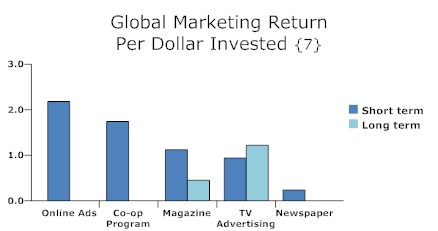 Section
Navigation
Section
Navigation
6. Marketing the Business
:Identifying the Customer
6.1 Keyword Research
6.2 Market Segment
6.3 Customer Tracking
6.4 Metrics
:Campaigns
6.5 Marketing Campaigns
6.6 Marketing with Social Media
6.7 Marketing with Mobile Platforms
6.8 Selling through Affiliates
6.9 Press Releases
6.10 Copy Writing
6.11 Pay per Click Marketing
6.12 Search Engine Optimization
6.13 Improving the Business
 6.5
Marketing Campaigns
6.5
Marketing Campaigns
Internet marketing campaigns follow market research, i.e. companies first
identify their market niche and segmentation and then devise cost-effective
ways of reaching their preferred customers. In short, they have:
1. Found out what potential customers really want by surveys, market
research, and customer tracking on their existing website(s).
2. Assessed the competition, their strengths and their marketing approaches.
3. Focused on what they can do and their competitors can't: the unique
selling proposition.
4. Devised clear contingency plans to counter competitor moves against
them.
5. Looked at potential new markets.
6. Constructed a timetable for traffic levels, conversion rates and
sales.
7. Costed each marketing phase accurately.
8. Set up contingency plans for unexpectedly high or low sales.
With a Website
Internet companies may sell goods and services through emails, blogs, content management systems, distance learning and other platforms. If a company website is required, that site has to:
1. Reflect the unique selling proposition, and the company's market
position vis-à-vis the competition.
2. Have a professional appearance, inspiring trust and confidence.
3. Be designed around the selling process. Copy must draw visitors in,
emphasizing value to them. Navigation should be clear and trouble-free
— not merely possible to follow, but impossible to get lost in.
4. Testimonials should be placed strategically (and be genuine).
5. Guarantees and returns policies should be clearly stated (and adhered
to).
6. Email and telephone (preferably toll-free) support should feature
prominently.
Types of Internet Marketing
Internet companies market their products by some combination of:
1. Websites well-ranked by the search engines (search engine optimization).
2. Pay-per-click advertising campaign.
3. Email marketing campaign.
4. Social media (including blogs).
5. Selling through affiliates.
6. Press releases.
7. Conventional, off-line advertising.

Not all advertising is created equal. Nielson found: {7}
1. The global return (in 3 months) on all advertising media averaged
$1.09 per dollar spent, i.e. 9%.
2. Return varied with the medium employed, from $2.18 for online ads
to a paltry 24 cents for newspaper advertising.
3. An extra 30-40% return could be achieved by using each medium more
effectively.
4. Over-promotion and excessive discounting had a negative impact.
5. Markets differ: online ads are more effective in China than in the
US or Europe.
Setting Objectives
All campaigns set targets, which are commonly aim to:
1. Earn more direct revenue per ecommerce effort.
2. Reach new customers
3. Communicate better with existing customers.
4. Establish a base from which to market future products and services.
5. Connect better with people in different demographic groups.
6. Increase referral business.
7. Reposition the business or brand.
Deciding the Metrics
Given the sheer volume of data that customer tracking programs generate, companies first decide what they will measure ('metrics) on a regular and consistent basis, and then analyze those metrics in a spreadsheet program before making visual presentations for management meetings.
Running the Campaign
Marketing is less a technique than an education. Rooted in an understanding of how people instinctively think and feel, marketing has to find a way of accommodating whatever is being sold to a particular conception. The product or service may not be the best going, but it has to satisfy perceived requirements, creating a relationship that is both sympathetic and reassuring.
The only sure way of marketing a product is therefore to plan intelligently, follow the plan meticulously, assess results, and keep modifying the plan. Even minor changes to copy and page layout may alter visitor performance and sales, which is a reason for continually experimenting and monitoring the appropriate metrics carefully.
 Questions
Questions
1. What is a marketing campaign, and what are its common objectives?
2. Names six types of Internet-based marketing campaigns.
3. How can a web site be part of a marketing campaign?
4. Marketing campaigns are continually modified. Discuss.
 Sources and Further Reading
Sources and Further Reading
1. Clickz.
Articles and advice from one of the market leaders.
2. Marketing
Experiments. Reports and monthly newsletters are now
free.
3. Idea
Site for Business. Marketing ideas for entrepreneurs and the
smaller business.
4. Ad Resources.
Articles and statistics on Internet advertising.
5. Promotion
World. Hundreds of free articles on promoting websites, with
reviews of services and products.
6. Internet
Marketing. Advice, books, links and brief software reviews.
7. Is Your Marketing Investment Delivering Expected Return? Nielson.
October 2009. Short promotional document.